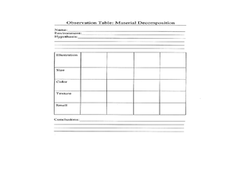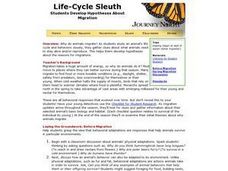Council for Economic Education
Cost/Benefit Analysis: Three Gorges Dam
Students, in groups, take various roles in evaluating the costs/benefits of the Three Gorges Dam project on the Yangtze River in China.
Curated OER
Environmental Law-Making
Students go through the process of creating and passing a federal law. They select an environmental issue, research related policies for the issue, draft the bill, discuss it among committee members, bring it before the class and bring...
Curated OER
Slow Rot or Not?
Fifth graders examine how environmental factors affect decomposition. In this decomposition lesson, 5th graders experiment with the decomposition of grapes in five different environmental settings. They look at images of items that have...
Curated OER
The American Trail System
Learners research a trail system. They create a display board of the trail system, generate a map of the trail system, and develop a commercial advertising of the trail system. They design a display board featuring facts about the...
Curated OER
Insects
Third graders research an insect and creates a brochure on that selected insect. Each student develops a Venn Diagram comparing similarities and differences between moths and butterflies.
Curated OER
Savanna Hands-On Biome Building
Fifth graders participate in an interdisciplinary project related to the Savanna biome. In this biome building lesson, 5th graders display the elements of the Savanna biome such as the geography, animals and plants, and precipitation...
Curated OER
Hide In Plain Sight
Students view video clips and use the Internet to look for hidden animals. They then use the Internet to print out animal shapes and color them. They create environments on construction paper in which their animals can hide.
Curated OER
Westmoreland Trail
Seventh graders complete a unit of lessons on the Westward expansion of the U.S. They play the computer game, Oregon Trail III, read primary source documents, conduct Internet research, write diary entries from the pioneer viewpoint, and...
Curated OER
Turtle Lesson
Learners explore the five common turtles that are native to the eastern United States. They investigate each turtle's characteristics, environment, means of protection, eating habits, and show how they can help these turtles survive.
Curated OER
Explore Your Natural Habitat
Students identify habitats and understand why they are important to our environment. In this environmental lesson students design their own habitat, observe and record data on the impact their habitat has on the environment.
Curated OER
Let's Heat Things Up!
Students build and evaluate simple models to understand the greenhouse effect. They explore the role of increased greenhouse gas concentration in global warming, and the implications of global warming theory for engineers, themselves...
Curated OER
Dangers Of Radiation Exposure
Students investigate the effects of radiation exposure and how it can effect objects on earth and space. They conduct research using a variety of resources and use the information to create a project that is reflective of good research...
Curated OER
Women Immigrants in the Promised Land
High schoolers examine the experience of female immigrants as they arrive in the United States. They create a timeline of women's rights in the U.S., write journal entries, conduct Internet research and read online excerpts from "The...
Curated OER
Unit Plan Template
Learners research the adaptations of desert animals and build their research skills. In this the adaptations of desert animals activity, students describe major factors that desert animals have on their habitat. Learners explore how to...
Curated OER
Life-Cycle Sleuth
Learners analyze an animal's life cycle and behaviors, and examine what animals need to stay alive and reproduce. They develop theories and hypotheses about the reasons for migrations, using the Journey North online project.
Curated OER
The First North Americans
Students identify and interpret the different North American Indian groups, by region, and the type and impact of their interaction with Europeans.
Then they complete an overview of one main Native American group during the age of...
Curated OER
Adventure Writing: Oregon's Landscape as a Setting
Students identify geographical features of different regions encountered by migrants on the Oregon trail. Students research how the Oregon landscape may have affected life and 19th century westward migration. Students write a narrative...
Curated OER
The Last Great Race
Third graders identify and discover why the Iditarod race is done each year. They explore the historical significance of the Iditarod. Students also use web sites to research related topics, i.e. diseases (diptheria), geography of...
Curated OER
Antebellum North Carolina
Eighth graders examine pictures & documents relating to the Hayes Plantation (Edenton, NC). They also use various maps of North Carolina to help them analyze how James Cathcart Johnston used, modified and adapted to the physical...
Curated OER
Energy Alternatives
Students brainstorm a list of all of the ways they use energy in a day. In groups, they research the energy situation today and discuss what is being done to solve the problem. They also examine the issues related to this in politics...
Curated OER
Food Webs in the Barnegat Bay
Students investigate the food webs in the Barnegat Bay. In this organisms activity, students use a graphic organizer to illustrate the types of consumers in the bay. Students use reference books to continue to research the animals found...
Curated OER
Earth's Biomes
Tenth graders examine characteristics and animals of terrestrial biomes. In this Earth's biomes lesson plan, 10th graders view a PowerPoint, take noes, sort pictures, research biomes, and create a diorama of a biome for presentation.
Curated OER
Robotics
young scholars identify and research robots in various roles in society, and create robotic arms and multimedia presentation based on their findings.
Curated OER
Physics Park
Students research and design a playground for a park or school in their community. They explore the physics concepts that are present in the design and, if applicable promote their ideas to city or school officials.

























